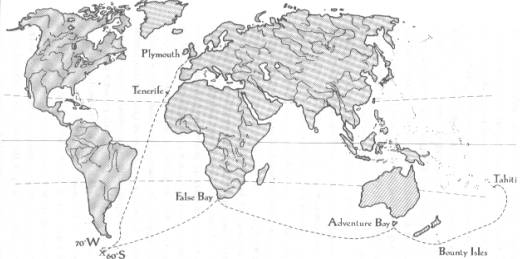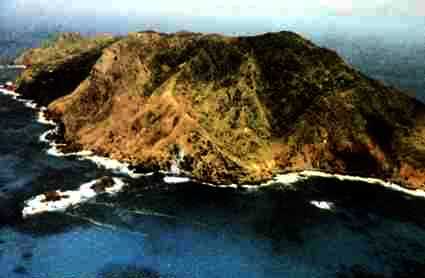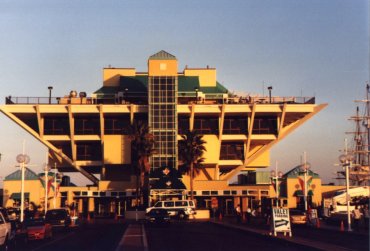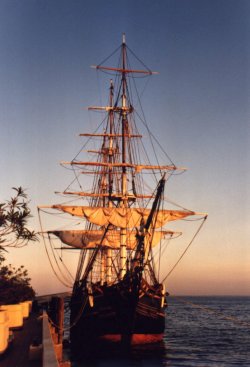|

The Mutiny That Never Ended ...by Bill Knell
Controversy has always surrounded the infamous tale of the HMS Bounty. It’s most famous, ill-fated and final voyage began out of England in 1787. Touted as a voyage of scientific importance by the shy British, the reality was that the ship was sailing to Tahiti for the collection of breadfruit saplings. These were to be transported to Jamaica, planted and used as a food source for slaves working on the plantations. After sailing nearly 27,000 miles over ten months, the Bounty arrived in Tahiti. Allowing just enough time for the collection of the saplings, the ship sailed off toward Jamaica on April 4, 1789. What happened next has always and will always be disputed.

After three weeks under sail for Jamaica, first mate Fletcher Christian and those loyal to his cause took control of the Bounty in mutiny against Captain William Bligh. The captain and eighteen sailors still loyal to him were set adrift in a small open boat near the island of Tonga. Allegedly fearing the possibility of cannibals on Tonga, Bligh sailed in another direction. The captain and his supporters survived a 3,600 mile, seven week ocean voyage to the Indonesian island of Timor. After the mutiny, Christian and his men returned to Tahiti to reunite with their native lovers. Sixteen of the twenty-five Mutineers decided to remain there while Christian, eight crew members, their women and a few Tahitian men sailed on in search of a safe haven.

On January 23, 1790, Christian and his crew arrived on the tiny volcanic island of Pitcairn. Almost 1400 miles from Tahiti, the island is just 1 ¾ miles square. Originally sighted by a British Midshipman named Robert Pitcairn in 1767, it was charted incorrectly at a later date and virtually forgotten about by the time the Bounty arrived there. Despite a thorough search for the Mutineers by the British Navy, Christian and his group weren"t found. The remainder of the Mutineers who stayed on Tahiti were located and returned to England where a trial lead to seven exonerations and three hangings.

Despite misgivings about Bligh’s behavior, the British Admiralty decided that an indictment against him would be an unnecessary blemish on the British Royal Navy. They lauded his accomplishments and seamanship, punished what Mutineers they could and later appointed Bligh the Governor of the New South Wales colony in Australia. Some say he was merely showing his true colors when the colonists of New South Wales held their own mutiny against Bligh after just three years under his rule. Claiming he was a tyrant and ill-suited for the position of Governor, they arrested Bligh and shipped him back to England. But even after two instances of mutiny, the British Admiralty did not want this nasty man to defame the entire Navy. Again, no punishment was rendered and Bligh was later promoted to the position of Vice Admiral. By the time an American Whaling ship re-discovered Pitcairn island in 1808, only one Mutineer was left alive. The others had been murdered or committed suicide. The last surviving Mutineer, John Adams, took control of the island and restored civility. With an emphasis on religion and education, he managed to pull together the population of under 100 and restore the dream of a peaceful paradise where people could live a carefree lifestyle. In 1825, a British ship arrived at Pitcairn with an offer of amnesty for Adams and in 1838 the small island became a part of the British Empire.

If would be easy to argue about the mutiny against Bligh for a lifetime. This is simply a case where you had to be there to know what really happened. For over two hundred years it was just assumed that Bligh was a puppet of a Royal Navy known for its inhumanity and brutality, who got what he deserved. The entire purpose of the voyage was to provide food to support the system of slavery in Jamaica, so very few people cared to look into the case too deeply. Regardless of whether Bligh was a brutal captain with a god complex or just a strict leader who was intent on completing a mission being watched closely by the British Admiralty, one can hardly blame the crew of the Bounty for wanting to escape the horrendous onboard conditions of such a long voyage for the paradise and free love lifestyle of Tahiti and the South Pacific islands.

The first time I walked on board an exact replica of the HMS Bounty in 1971, I could easily understand why anyone would want to get off that ship. Despite the fact that it was an ocean going vessel, the ship was nothing like I had expected it to be. It was tiny! My tour of the ship took less then ten minutes even after stopping to watch a small canon fire and reading every informative plaque on the vessel. Inside the ship it was hot and uncomfortable, despite large open windows. In some areas there was barely room to stand up.

Although it wasn’t Tahiti, I guess I felt like one of the crew members might have when leaving the discomfort of the ship. The airy pier in Saint Petersburg, Florida, where the HMS Bounty replica had become a welcomed tourist attraction was much preferred to the small deck area and stuffy insides of the ship. The air conditioned gift shop associated with the vessel was even more pleasant. It contained a large selection of books, keepsakes and tourist junk related to the ship’s theme. But I wasn’t a tourist. My family moved from New York City to St Pete, Florida, in 1970. The town was surrounded by beaches and featured a number of attractions for visitors who filled the place to overflowing during the tourist season. With a whole summer to endure before high school started up for me again, I took advantage of a generous public transit system and short lines at historical sites throughout my new city of residence. By 1971, I was in my fifth year of major interest in the paranormal. After winning an essay contest sponsored by a tabloid, I had gained some national notoriety by publicizing some odd communications between NASA and the Apollo Astronauts related to UFO sightings in space and near the Moon. My other major interest was history. I was completely thrilled to learn that I had moved to a town with at least a dozen small historical museums. As the winter months came and school started up, my forays to local historic sites became less frequent. But the story of an actual Egyptian Mummy being available for close examination at the small historical museum adjacent to the downtown Pier was too much to resist. I headed for the museum on a mild September weekend. Standing right in front of a real mummy and being able to almost touch it was quite an experience for me. But what happened next was no less exciting. Although most of the tourists walked right past the little museum and up to the Bounty or out to the end of the pier, some took a few minutes to investigate it’s small interior. There wasn’t much room and everything was packed closely together, but that made it easy to overhear almost any conversation going on in the place. I had arrived on a particularly slow day, so the elderly woman who had volunteered to sell tickets and run the small souvenir counter was catching up on her reading when a male friend walked in. He worked just up the pier at the Bounty and brought a small lunch for both of them to share. Still in awe of the Mummy and reading the story cards placed near it, I didn’t really listen to the conversation between the volunteer and her friend until the word GHOST popped into my ear. I maneuvered around the tightly packed exhibits to get a bit closer to the souvenir counter. Feigning interest in the tourist junk, I listened to the two friends talking. It seemed that a few tourists had noticed some cold spots below deck on the Bounty and asked those in charge why the air conditioning in the rest of the ship’s interior wasn’t working? At the same time, some workers in the gift shop expressed dismay at arriving to items being found on the floor or moved to locations where they didn’t belong. I was intrigued and overcame my less then outgoing nature to ask the two a few questions. As it turned out, the elderly couple were impressed that a young person in those days might be interested in something other then anti-war protests. It seems that the Bounty replica had more then a slightly odd history. The vessel was built in 1960 at a ship building firm in Nova Scotia from original Admiralty plans used for the real HMS Bounty. It took nine months to complete the ship for the 1962 film version of MUNTINY ON THE BOUNTY, starring Marlon Brando and Trevor Howard. At a staggering cost of $650,000, it became the most expensive movie prop ever built at that time. Like the original ship, the replica was supposed to be burned near Pitcairn island during the last few days of filming. But an expected savior stepped in.

During production, Marlon Brando gained a new respect for the plight of the real HMS Bounty Crew. He made sure that the extremes under which common seaman were forced to live during that period of history came to life on film, but didn’t want it to end there. Brando felt that if the ship were exhibited to the public, people might understand how terrible living conditions onboard had been for the Mutineers. These feelings may have come from a place deeper then just Brando’s sense of social justice. During filming, the director and other cast members became concerned about Marlon Brando. He had emerged himself so deeply in the part of Fletcher Christian that it became increasingly harder to tell where Fletcher left off and Marlon began. It was almost as if the spirit of Fletcher Christian had possessed the popular actor.

Rumors flew off the set and into the tabloids that problems with the production were Brando’s fault. He was described as difficult to work with and over emotional about the script. But Marlon’s concern for historical accuracy took a back seat to his new demand that unless the replica was saved for posterity, he wouldn’t finish the film. Despite their objections, MGM Studio executives agreed to save the replica. In return, Marlon would stop creating trouble on the set and finish the film. Thinking it would probably be a waste of money, MGM reluctantly placed the Bounty on exhibit in Saint Petersburg, Florida. They couldn’t have been more wrong. People loved the exhibit and the studio made a small fortune selling movie soundtracks, books and other items to the tourists. But not all the news was good. The replica arrived in St Pete with a history that included some strange events. Despite meticulous construction and for no apparent reason, the vessel would start to take on water during certain days when filming occurred. At other times, those recording the audio tracks on site complained of strange noises coming from the bowels of the ship. The noises weren’t heard until the tapes were played at a later time and resembled muffled, incoherent voices. But the sounds were dismissed as background noise traveling across the water. Since much of the dialogue would be re-recorded later and over dubbed into the film for clarity, this was not really a problem. Workers who were preparing the Bounty replica for public viewing and boarding after it arrived in St Pete had their own odd stories to tell. Mannequins were placed aboard so that some actual costumes from the film could be exhibited and historically-accurate scenes could be recreated aboard. Those dressing and positioning the mannequins complained that they would arrive in the morning and find much of the previous days work undone with positions being shifted and clothes falling off! It was only after the mannequins had been placed in certain positions that it all stopped. Some of the workers shrugged the whole thing off as someone’s idea of a practical joke or guaranteed overtime, but others were less sure. They seemed to feel that a force was at work which wanted the mannequins to be displayed a certain way, or not at all. My visit to the small Museum near the Bounty replica had yielded paranormal gold, but the best was yet to come. After scribbling a bunch of notes in handwriting that would win any doctor’s prescription an award for penmanship, I asked the Bounty worker (who I’ll call Chuck) if anything other then the cold spots had recently occurred? He told me it was time for him to go back to work, but if I could stick around until after four o"clock he would fill me in on the rest. I agreed and reluctantly called my parents. They really hated the fact of my interest in the paranormal, but were kindly tolerant since I was an only child. They said to call when I finished and they would pick me up. After I finished viewing everything in the Museum twice and walked around the area for a while, I headed toward the Bounty. Chuck was standing just outside the gift shop building. He was an older man who had retired to St Pete only to find that golf, shuffleboard and the small pension he received after years of working as a book keeper wasn’t making it for him. As a comptroller for the Bounty gift shop he was able to sit around in air conditioning all day, fiddle with some numbers, make a nice retirement wage and visit his friend at the nearby Museum. As I approached, another guy appeared. He was a college graduate in his early twenties who, like so many others who fell victim to the ongoing recession of that day, was unable to find real work and took the reasonably well-paying job of a tour guide on the Bounty. His name was George. After some quick introductions we walked over to an outdoor food vendor, grabbed some eats and sat down at a nearby picnic table. As the sun began to go down and the pier area filled with people out to enjoy the beautiful Florida sunset, George told me his strange tale. Everyone who had worked at the Bounty for any period of time knew the replica’s weird history. It was a right of passage. But George had been there just a short time and was still unfamiliar with those stories when he had his first weird experience. During the Bounty tour a guide would set off a small, rail-mounted gun (canon) to the delight of the tourists. All the new people got the duty of cleaning the gun and preparing it for use. After being carefully instructed on how to clean, use and fire the gun, George got the cleaning duty. Arriving early in the morning, he started work on the replica weapon. During the cleaning he pointed the barrel in towards the ship. After turning away from the gun for some supplies, he turned back to find the barrel pointing away from the ship. This happened a few times so George checked the mounting hardware. Although it seemed tight enough, he walked over to the gift shop and left word for the exhibit’s mechanic. About thirty minutes later the mechanic was up on deck. George explained the situation and the mechanic said, “Oh, that’s just Harry!” George asked, “Who?” It seemed that almost every new tour guide given the duty of cleaning the gun experienced the same phenomena. It would go on for a few days, then inexplicably cease. Rather then get upset about it, the staff figured there was some prankster ghost aboard and nicknamed him Harry. “Try asking Harry to stop,” the Mechanic suggested. “He likes it when new guys call him by name.” Sure enough, after George asked Harry to give him a break, the gun never turned by itself again. George thought that the whole thing had been a prank on the new guy arranged by the other workers, but went along with it. The next event changed his mind. Tour guides dressed in period costumes from the time that the famous mutiny took place. The week before I met him and Chuck, George was working around midday when it came time for him to take a break. As he prepared to head off to the gift shop, he saw a very scruffy looking man wearing a costume like his and heading down into lower deck area. He was surprised at the man’s appearance, because the costume seemed as dirty as the guy himself. He followed the man and walked down the steps into the bowels of the ship, but found no one there. Had he imagined it all? Later that day some tourists reported cold spots in the same place where the unkept man had been. Employees had noticed the spots on previous occasions, but in different spots. While all this craziness was going on the gift store problem persisted. Books, tapes, records and souvenirs were still being moved around at night. Those who worked at the replica were first annoyed, but now concerned. The following Monday was a day off from school due to teacher conferences. I asked Chuck if I might come to see the store early Monday morning and view any objects that had been moved the night before. He agreed, but asked me to keep things quiet. Since St Pete was known as the city with a Church on every street corner, I had no problem with that. I took an early bus downtown on Monday and walked to the pier. Chuck arrived at a few minutes after eight o’clock and we entered the gift store. In one corner near where some books about the Bounty were kept for display and sale, I saw several items laying on the ground. The same situation was present near the cash register. Maybe it was just that the old pier moved during times when no one was there to notice or some employee thought this was a great way to annoy their boss? I was still trying to play the skeptic when I noticed something. Several books that were stacked on the register counter were also available for sale on the other side of the room. I asked Chuck if the objects found on the floor or moved around were always found in the same places? He said they were. I asked him how long this had been going on? He said for a couple of months. A short time later, the gift shop cashier arrived. I asked her how long the book title on the counter and the other side of the room had been available for sale at the store? She told me they started carrying it a couple of months ago. Although I don’t recall the exact title, the book was a conspiratorial paperback that told the story of the Bounty from another angle suggesting that Fletcher Christian had planned the Mutiny even before the ship left England. Some sort of weird conflict between the two families became the basis for this convoluted work. But the book was a fast read and cheap enough to be popular with tourists who often purchased paperbacks to read while getting a tan at the pool or beach. I asked Chuck if he could arrange to shelve the books in the storeroom for a few nights. Seeing where I was coming from and tired of cleaning up the mess every morning, he agreed and figured the manager probably wouldn’t notice if it was only for a few days. I suggested they replace it with a paperback that took a more sympathetic view of the Mutineers plight. They did. The following week I stopped by the Bounty to see Chuck. He had a big smile on his face and dragged me into the gift store. “Here’s the kid who solved our little problem!” I was introduced to the Manager of the store and exhibit. Although not totally comfortable with admitting that anything paranormal had happened in the first place, he agreed that my literary suggestion had stopped the overnight mess and damage. Being from Chicago, he had been brought up with enough mid-western ghost stories to at least consider the possibility that something strange had happened. But mostly, he was just happy that his little store was finally at peace. I suggested he not annoy the Mutineers with any more book titles that weren’t friendly to their cause. He agreed. I stayed in touch with Chuck for another year. George found a real job and moved. The cold spots continued, but no more visible manifestations were seen during that time that I was aware of. The gift shop remained at peace. In my mind, it was obvious that the ghost of one or more Mutineers shared Brando’s concern that people not forget how bad things were for everyone who served under the British Naval system in those days. They would probably remain with the replica as long as it was intact to be sure those presenting the history of the Mutiny did so in the Mutineer"s favor. Ships have always had a connection to the paranormal. The abandoned Mary Celeste found drifting with no one on board will always be associated with the mysterious Bermuda Triangle disappearances. The FDR is known as the UFO aircraft carrier because of the number of unusual encounters it’s had. The USS Hornet has been called the most haunted ship in the Navy, because of all the deaths and persistent stories of ghosts on board. It has the highest suicide rate of any ship in the military. The Queen Mary has given birth to hundreds of stories involving ghosts and psychic encounters. From a paranormal standpoint, it’s possible that shipboard hauntings come about because ghosts tend to associate themselves with people, places or things that gave them the most happiness or controversy while still alive. Such may be the case of Robert Lewis Stevenson. The author of such literary masterpieces as Treasure Island, Kidnapped and The Strange Case of Dr Jekyll and Mr Hyde spent the last few years of his life in the South Pacific. To get there, Robert Lewis Stevenson chartered a sleek vessel known as the Casco in California. The three months he spent on that ship were said to be some of the happiest times he ever had. While the vessel was being rebuilt at a ship yard a few years back, workman became concerned when tools were moved around and small power failures took place as work on the Casco began. Things got worse when smaller vessels surrounding the scaffolded Casco were found overturned or out of place ruining paint or repair jobs completed the previous day. Everything came to a head when a tall, gaunt figure was seen moving about the ship in the early evening on various occasions while no one was on board. A worker at the ship yard who was restoring his own small craft was a fan of Stevenson. He knew what the author looked like and pointed out that the descriptions provided by others who saw the figure match that of Stevenson. More importantly, he knew that Stevenson had once been on the ship and that his favorite time for walks on the deck had always been the early evening. After that, the repair job was rapidly completed and the ship sent on it’s way. I doubt that anyone was sorry to see it go! Authors and poets have described our connection to the sea in the beautiful terms. But like every other part of life, the best and worst of things that happen can occur on ships. And for some of us, the consequences of those events may be more eternal then for others.
Book Titles We Highly Recommend - Informative and Fascinating - Helps To Support This Website



|





